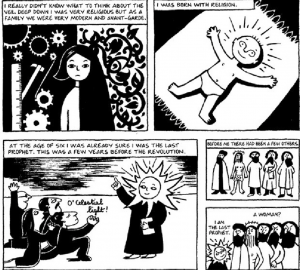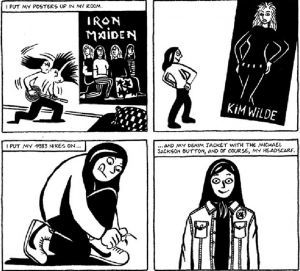Religion and Counterculture: Through the Lens of Persepolis
Hello readers!
My apologies for the absence! Midterm season has slowly come to a halt and oh, we have been busy with multiple papers and exams. In our ASTU class here at the University of British Columbia, we have been chipping away at literature reviews, furthering our knowledge of scholarly style, reading Safe Area Gorazde by Joe Sacco, and Obasan by Joy Kogawa!
However, today I will be analyzing the roles of religion and counterculture as progressive narratives in the life of Marji, the protagonist in the graphic memoir Persepolis: The Story of a Childhood by Marjane Satrapi. I will also be drawing points from my fellow classmate Kristen Lew’s blog post entitled “Persepolis and Cultural Imperialism”.
Persepolis is set in the middle of growing tensions in Iran, a devastating war, and Islamic Revolution. We see these events through the lens of an innocent child, Marji, who tries to make sense of the world around her.
What fascinates me most about this graphic memoir is the shift in roles religion plays in the life of Marji, where she adopts an almost westernized countercultural taste towards the latter half of the book after the Revolution. This “cultural imperialism” – the imposition of one dominant culture on other cultures (Guppy and Ritzer 136) – is in part yielded by the phenomenon of globalization.
Right from the get-go, we see religion imposed on Marji, who in part sees the veil as something she must embrace having been “born with religion” (Satrapi 9). This notion of being born with religion is what fuels young Marji to think she is in fact the last prophet; having her private conversations with god, speaking out for the weary and injustice, even going so far in having her own holy book (9). All of this, however, changes as the Islamic Revolution heightens.
Where once our protagonist walked so close with god, as Marji grows up, religious tradition becomes more of a grudging duty and is questioned all the more as blood is shed in the name of religion. As religion heightens in the world around Marji, she in turn does a full 180, reverting to and adopting westernized culture. The chapter entitled “The Cigarette” seems to be the biggest turning point in the narrative in my opinion, where she becomes fed-up of being coerced by the religious regime, “with this first cigarette, I kissed my childhood goodbye” (117).
Kristen Lew writes in her blog:
The dominance of Western culture over Marji’s native Iranian culture is clear in her choice of idols as she enters her pre-teen years: Kim Wilde, Michael Jackson and Iron Maiden top the lists. She rebels by showcasing Nike shoes and a jean jacket — elements of Western material culture. She rejects many material aspects of the Iranian culture —wearing the veil and following [Islamic] practices.
Through the seems of a strict Islamic culture set up by the regime, Marji is still able to adopt this counterculture notion, embracing westernized ideals.
The story of Persepolis and the author, Marjane Satrapi speaks volumes to the power religion plays in the lives of people every day, but also this ethnocentric view that the western culture is superior above the rest – that if you do not dress a certain way, talk in a certain manner, posses a certain trend, you are not living the “right way”.
A personal anecdote in my life where I saw and experienced this “cultural imperialism” first-hand was in the Spring of 2013, when I went to the Philippines on a missions trip with 18 other young adults from my Church for two weeks. As we walked through the streets of Manila, what struck me the most was the amount of western culture was present half way across the world. From the advertisements and huge billboards, the way people dressed, and the amount of attention we gathered (not necessarily me because I am Asian ha ha, but my Caucasian peers) in which we felt like superstars from this ‘grandiose land of dreams’ called Canada.
This sparks questions which still trouble me to this day: who decides the dominant culture? Why is western culture what people often strive to obtain? What are the troubles of adopting various cultures from around the world and implementing them to your every day life? What if the so-called ideal western culture is not suited for where you live, in fact hurting others around you?
Cheers,
Nico Jimenez


